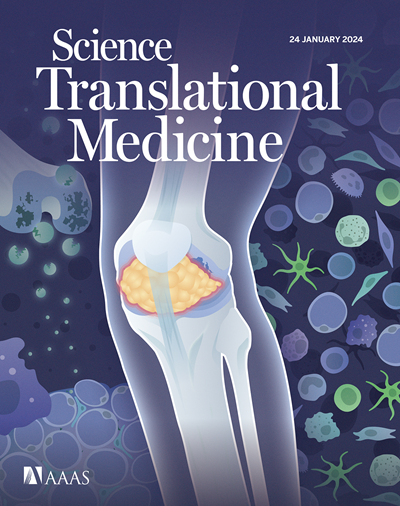Somatic mosaicism in the buccal mucosa reflects lifestyle and germline risk factors for esophageal squamous cell carcinoma
IF 15.8
1区 医学
Q1 CELL BIOLOGY
引用次数: 0
Abstract
Clones harboring cancer driver mutations can expand in normal tissues, known as somatic mosaicism, and can be influenced by age and environmental and germline factors. Somatic mosaicism in the blood predicts the risk of hematological malignancies; however, the relevance of somatic mosaicism to solid tumors remains unclear, in part because of limited sample availability. Lifestyle habits, including alcohol consumption and tobacco smoking, and pathogenic germline variants increase the risk of developing esophageal squamous cell carcinoma (ESCC). Because somatic mosaicism in the esophagus is known to be associated with aging and lifestyle habits and considering the contiguity of squamous epithelium from the esophagus to the oral cavity, we noninvasively collected buccal mucosa samples from patients with and without ESCC using swabs of different sizes and conducted deep error-corrected sequencing of 26 cancer driver genes to obtain comprehensive landscapes of tissue remodeling by driver-mutant clones. We found that the number of mutations increased with drinking, but only in individuals with germline risks. Moreover, across positively selected genes in the buccal mucosa, mutations increased with age and smoking regardless of germline risks, whereas drinking affected only those with germline risks. The buccal mucosa of patients with ESCC was extensively remodeled, and models predicting the presence of ESCC demonstrated high accuracy with smaller swab sizes, possibly because of their higher sensitivity in detecting small mutant clones. In conclusion, we showed that buccal mucosal remodeling reflects lifestyle and germline risks, as well as age, which might be exploited for noninvasive risk assessment of ESCC.
口腔黏膜的体细胞嵌合体反映了食管癌的生活方式和种系危险因素
含有癌症驱动突变的克隆可以在正常组织中扩展,称为体细胞嵌合体,并可能受到年龄、环境和种系因素的影响。血液中的体细胞嵌合体预测血液恶性肿瘤的风险;然而,体细胞嵌合与实体瘤的相关性尚不清楚,部分原因是样本有限。生活习惯,包括饮酒和吸烟,以及致病性种系变异增加了发生食管鳞状细胞癌(ESCC)的风险。由于已知食管中的体细胞嵌合与衰老和生活习惯有关,并考虑到食管与口腔鳞状上皮的邻近性,我们使用不同大小的拭子无创收集ESCC患者和非ESCC患者的口腔黏膜样本,并对26个癌症驱动基因进行深度错误校正测序,以获得驱动突变克隆的组织重塑的全面视图。我们发现,突变的数量随着饮酒而增加,但仅限于有生殖系风险的个体。此外,在口腔黏膜的正选择基因中,突变随着年龄和吸烟而增加,而不考虑生殖系风险,而饮酒只影响那些有生殖系风险的人。ESCC患者的口腔黏膜被广泛重建,预测ESCC存在的模型在较小的拭子尺寸下显示出较高的准确性,可能是因为它们在检测小突变克隆时具有更高的灵敏度。总之,我们发现口腔粘膜重塑反映了生活方式和生殖系风险,以及年龄,这可能被用于ESCC的无创风险评估。
本文章由计算机程序翻译,如有差异,请以英文原文为准。
求助全文
约1分钟内获得全文
求助全文
来源期刊

Science Translational Medicine
CELL BIOLOGY-MEDICINE, RESEARCH & EXPERIMENTAL
CiteScore
26.70
自引率
1.20%
发文量
309
审稿时长
1.7 months
期刊介绍:
Science Translational Medicine is an online journal that focuses on publishing research at the intersection of science, engineering, and medicine. The goal of the journal is to promote human health by providing a platform for researchers from various disciplines to communicate their latest advancements in biomedical, translational, and clinical research.
The journal aims to address the slow translation of scientific knowledge into effective treatments and health measures. It publishes articles that fill the knowledge gaps between preclinical research and medical applications, with a focus on accelerating the translation of knowledge into new ways of preventing, diagnosing, and treating human diseases.
The scope of Science Translational Medicine includes various areas such as cardiovascular disease, immunology/vaccines, metabolism/diabetes/obesity, neuroscience/neurology/psychiatry, cancer, infectious diseases, policy, behavior, bioengineering, chemical genomics/drug discovery, imaging, applied physical sciences, medical nanotechnology, drug delivery, biomarkers, gene therapy/regenerative medicine, toxicology and pharmacokinetics, data mining, cell culture, animal and human studies, medical informatics, and other interdisciplinary approaches to medicine.
The target audience of the journal includes researchers and management in academia, government, and the biotechnology and pharmaceutical industries. It is also relevant to physician scientists, regulators, policy makers, investors, business developers, and funding agencies.
 求助内容:
求助内容: 应助结果提醒方式:
应助结果提醒方式:


